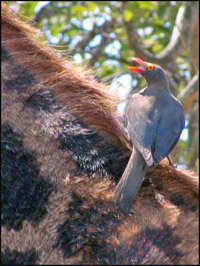- A giraffe is able to clean its ears with its own tongue.
- Giraffes live for 10-15 years in the wild, but average 25 years at zoos.
- Other animals on the savanna use giraffes as watchtowers or observation posts for predators.
- It's difficult to catch a giraffe while its sleeping, simply because he gets so little of it! Ever vigilant for predators, giraffes just sleep for a few minutes at a time, and usually only get about 30 minutes total in a single day.
- The tallest mammal in the world is the giraffe.
- In the savannah region south of the Sahara in Africa, the giraffe feeds primarily on acacia leaves.
- Giraffes can eat up to 77 pounds (35 kilograms) of food every day. They do not eat meat, but prefer the leaves and tender shoots of trees and shrubs. Their favorite meal, the leaves and twigs of the thorny acacia tree, have all the nutrients a growing giraffe needs, except for calcium and salt. The leaves also contain a lot of water, making water holes much less of a necessity. With that kind of motivation, it's no wonder they like the acacia so much!
- The average giraffe's blood pressure is two or three times that of a healthy man.
- The giraffe can drink 12 gallons in one setting.
- A giraffe can go without drinking water longer than a camel can.(Source) Giraffes can go for days without water, which actually protects them from some of the dangers that more water dependent animals have. This is because predators, such as lions, frequent water holes, knowing that their prey must come to drink. By avoiding those places as much as possible, giraffes improve their chances for survival. Also, to get a drink, a giraffe must awkwardly splay out its front legs to reach the water, making it difficult to not only see its enemy, but also to get a good start running. And a giraffe must look out for those crocodiles... the ones that lunge out from the water and pull your carcass under. Besides the lion, crocodiles are natural enemies of giraffes. Giraffes can get most of their water needs from the luscious plants they eat, which helps to protect them from the dangerous water holes.
- In Atlanta, Georgia, it is illegal to tie a giraffe to a telephone pole or street lamp.
- Newborn giraffe calves begin their lives by falling 6 feet to the ground
- Giraffes belong to the family Giraffidae, which has only one other species, the okapi.
- Giraffes live in both open savanna areas and wooded grasslands.
- A baby giraffe is about six feet tall at birth.
- Giraffes have one of the highest blood pressures of all animals, due to their height and the large size of their heart.
- Ever see a fainting giraffe? If a giraffe's neck didn't contain pumping ventricles in its neck as well as its heart, then the animal would black out every time it raised its head to eat. A giraffe's heart is very big and very busy, pumping up to 20 gallons (75 liters) of blood every minute, and weighing up to 25 pounds (11 kilograms).
- A giraffe has just 2 gaits, walking and galloping.
- Just like humans, giraffes have seven vertebrae in their necks. Unlike humans, however, each vertebrae is about 5 inches (11 centimeters) long. The neck of an adult giraffe is about six feet long (1.8 meters), and is extremely muscular.
- Thinking that its parents were a camel and a leopard, the Europeans once called the animal a "camelopard."
- Giraffes are the tallest land mammals in the world. With all that height, comes the advantage of being able to see predators from great distances-- especially out on the open grasslands. But vigilance is just one of a giraffe's defense mechanisms. When attacked, a giraffe will use its large powerful hooves, and kick at its enemy. And a kick from a giraffe is no laughing matter. They have been known to sever lions' heads.
- Seeing spots? Did you know that the spots on each giraffe are distinctive to that animal alone? Because of this, people who are familiar with giraffes (such as researchers), can often identify each animal merely by recognizing their spot patterns.
 Giraffes can often be seen with small, winged passengers perched on their backs. These birds are called "oxpeckers," or more commonly known as "tick-birds," because they eat the ticks off animals, including grateful giraffes. The birds get fed, and the giraffes rid themselves of parasites. Nature working in harmony. By the way, these useful birds also like the giraffes' earwax, and will travel deep into the ear to get it. Yum!
Giraffes can often be seen with small, winged passengers perched on their backs. These birds are called "oxpeckers," or more commonly known as "tick-birds," because they eat the ticks off animals, including grateful giraffes. The birds get fed, and the giraffes rid themselves of parasites. Nature working in harmony. By the way, these useful birds also like the giraffes' earwax, and will travel deep into the ear to get it. Yum!- The giraffe gets its name from the Arabic word "Xirapha," which means, "one who walks swiftly." Giraffes not only walk swiftly, but they run swiftly, as well. They have been recorded running as fast as 35 miles per hour (56 kilometers per hour)! To put that in perspective, humans run on average 10 miles an hour (16 kilometers). Since giraffes tire easily, they are unable to sustain these high speeds for very long, but can use these brief spurts of speed to help evade predators, such as lions.
References;
Source: nature-wildlife.com
Source: The Living Desert
Source: National Museum of Natural History
Source: Davidson Biology Department
Source: University of Colorado
Source: National Geographic Society
